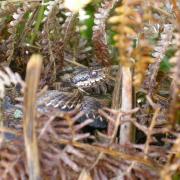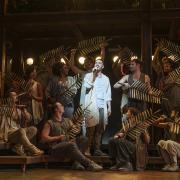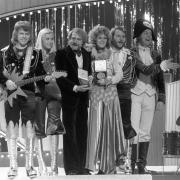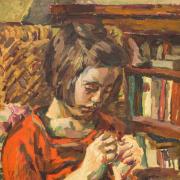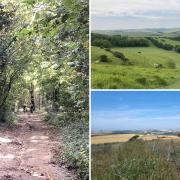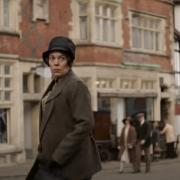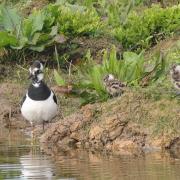Solution for the ‘Swan Song’ piece by Tony Ward in the Sussex Life May issue
Who is it? Swan Song
The Man of Property, first and last,
A change of name, a changing cast.
Novelist, dramatist, holding
a mirror to changing times.
Reflected lives.
.
Pen to paper but writing on the wall,
raising awareness, voicing concern.
.
Trilogy, dynasty, a wife held as property,
pleas on the page, a call for equality.
.
Honours accepted, knighthood rejected,
‘writing itself is a writer’s reward’.
.
Fame and fortune brought a Sussex home,
a Nobel Prize, the man for his time.
.
Swan song, the end of a saga,
end of a life, ash on the Downs,
.
forgotten. Revived, his readers now viewers,
on big screen, on small screen, for King and for Queen.
.
Setting new records, breaking new ground,
‘Upstairs, Downstairs’, scenes at the Abbey,
.
successors, successes, sequels. Yet
no more than dreams, no more than shadows.
Solution – John Galsworthy (1867 – 1933) – Novelist and Playwright
Explanation of embedded clues
The poem title “Swan Song” is both the title of the last book of his novel sequence, The Forsyte Saga, and a reference to Galsworthy’s last seven years, in Sussex. The Man of Property (1906) was not only the title of the first book, but also a measure of his own success, “first and last”, in that he himself became a ‘man of property’. In 1926 Galsworthy purchased Bury House, a 15-room mansion at Bury, North of Arundel. Bury House is now one of the stops on the 55-mile West Sussex Literary Trail, running from Horsham to Chichester. Throughout his life, through his writing, Galsworthy had campaigned against social inequality. This carried through into his personal life. As David Arscott reveals in The Little Book of Sussex, ‘He was conscious of his wealth, and every Friday one of his servants would tour the village with money in envelopes for local people in need’.
The Forsyte Saga was a massive undertaking, now perhaps best remembered as the record-breaking television series of the same name, the first of the dynastic sagas. Galsworthy wrote the sequence of books over a 22-year period. At one stage, he wondered whether he would manage to sustain the effort, ‘This idea, if I can ever bring it to fruition, will make The Forsyte Saga a volume of half a million words nearly’. It was “a mirror to changing times” seen through the lives of the characters that he created, “reflected lives”. The completed work consists of 6 books, arranged as two trilogies, separated in the series by World War I, and with linking short story ‘Interludes’. This was by no means his only output though. In his life-time he was mainly appreciated as a playwright. He also wrote short stories, poetry and literary and political essays, almost 100 works in all.
Although these other works were acknowledged in the Award Ceremony Speech, it was mainly for ‘his monumental chief work, The Forsyte Saga’ that he was awarded The Nobel Prize in Literature, ‘for his distinguished art of narration which takes its highest form in The Forsyte Saga’.
His early works were not however published under his own name, but under the pen-name John Sinjohn. They were published at his own expense and sold poorly, ‘for eleven years, I made not one penny out of what I, but practically no others, counted as my profession’. It was not until after the death of his father that he published under his own name, “A change of name”. “A changing cast” refers to his diversification into writing plays and to the start of The Forsyte Saga, following the lives of three generations of a large, upper middle-class family at the turn of the 19th-century. Both ventures were a success.
His plays usually highlighted some controversial ethical or social problem, “Raising awareness, voicing concern” – inequality under the law (The Silver Box, 1906), industrial relations (Strife, 1909), prison life (Justice, 1910), the class system (The Skin Game, 1920), and divided loyalties – family, employer, the nation (Loyalties, 1922). Such works were to lead to changes in the law and to social attitudes, “writing on the wall”. In the case of The Forsyte Saga the desire of the family to increase their wealth, particularly by property ownership, is portrayed as morally wrong. Galsworthy attacks the Forsytes through the character of Soames Forsyte, a solicitor who considers his wife, Irene, merely as “a wife held as property”.
“Honours accepted, knighthood rejected” refers to a period in Galsworthy’s life between the ages of 50 and 62. By 1917 he had already established his reputation as a campaigning playwright, as described in the previous paragraph. There were also other issues which he spoke out about, including censorship, women’s rights and animal welfare. This last had roots in his love of dogs, who feature in several of his works. This comes to the fore in the tender description in ‘Death of the Dog Balthusar’, (Book 2 of The Forsyte Saga), and his earlier essay ‘Memories’ (1912), an affectionate biography of his own black cocker spaniel.
In addition to his writing and campaigning he was respected for applying his principles to his personal life. After being rejected for active military service at the outbreak of World War I, he worked in France as an orderly at the Benevole Hospital for disabled soldiers. More than this, he signed over his family home for British soldiers recovering from war injuries. He also wrote articles for the War Propaganda Bureau (WPB) encouraging the public to give support to disabled and wounded soldiers. All these strands came together in his nomination for a knighthood by Prime Minister David Lloyd George. He turned it down, “writing itself is a writer’s reward”. He also turned aside repeated requests to stand as a Member of Parliament.
In 1921 he was elected as the first president of the PEN International literary club, whose members included George Bernard Shaw and H.G.Wells. This was an honour which was closer to his heart, recognition from his fellow writers. The organisation today focusses on supporting repressed writers across the world.
In 1929, he was then invited to join possibly the ‘most exclusive club in the world’, The Order of Merit (OM). He had no hesitation in accepting. The nomination is not in any way political, it is ‘in the personal gift of the sovereign’, King George V in Galsworthy’s case. The OM is considered the United Kingdom’s highest honour, there being at any point only 24 members, all outstanding people in their respective fields.
There was now only one greater prize for a writer. John Galsworthy was awarded the Nobel Prize for Literature in 1932. He donated the prize money to the PEN Trust Fund. Galsworthy was too ill to collect his prize in person though and died just six weeks later from a brain tumour. “End of a life, ash on the Downs”, in accordance with his wishes his ashes were scattered over the South Downs (from an aeroplane).
After his death, despite all his honours and fame within his lifetime, his reputation faded, his works “forgotten”. Then in 1967, three decades after his death and in the centenary year of his birth, “Revived, his readers now viewers”. As John Sutherland put it in his book How to be Well Read, The Forsyte Saga ‘rose from the grave’. The BBC turned Galsworthy’s text into a 26-episode black and white TV series starring Eric Porter as Soames and Nyree Dawn Porter as Irene. The stellar cast also included the likes of Kenneth More and Susan Hampshire.
The BBC used the series to promote the fledgling BBC2 channel, which at that time relatively few people could receive as it needed 625-line TV sets. The series, broadcast on Saturday evenings, attracted around two-thirds of the possible viewers. By the end of the series it had also resulted in a 30% increase in sales of 625-line sets. Repeated on Sunday evenings in 1968 on BBC1, the series broke all viewing records. Eighteen million people watched the final episode. During its run, Churches had to re-schedule Sunday evensong and ‘Jolyon’ (Kenneth More’s character) leapt up the rankings of popular names for baby boys. The BBC sold the series worldwide, including their first sale to the Soviet Union.
The series was a pathfinder, “Breaking new ground”, spawning similar large-scale drama series. The first “Successors, successes, sequels” included ‘The Pallisers’ and ‘Upstairs, Downstairs’, and recently of course we had ‘Downton Abbey’,
But what about the line in the poem, “on big screen, on small screen, for King and for Queen”?
The BBC wasn’t the first to dramatize Galsworthy’s work. MGM bought the film rights in 1937, and after several false starts released ‘That Forsyte Woman’ in 1949, with Errol Flynn as Soames and Greer Garson as Irene. In this original other cast members included Walter Pidgeon, Robert Young and Janet Leigh. The film was chosen for the Royal Command Performance on 17 November 1949, attended by King George VI, Queen Elizabeth the Queen Mother and Princesses Elizabeth and Margaret. There have also been other adaptations of The Forsyte Saga since 1968. A number of Galsworthy’s other works have also received exposure on radio, film, TV or the stage, from 1931 (The Skin Game, Alfred Hitchcock) to the present day (Strife, 2016, Chichester Festival Theatre).
John Galsworthy did not of course survive to enjoy the big money his saga made, but as D.H. Lawrence commented on the success of Galsworthy’s books at the time, “Just money!”
The final line of my poem, “Yet no more than dreams no more than shadows” perhaps reveals Galsworthy’s own more prosaic view of his life’s work. Prefacing Part I, Chapter I of Swan Song, the last book of The Forsyte Saga, he quotes Shakespeare’s famous lines:
‘We are such stuff
As dreams are made on, and our little life
Is rounded with a sleep.’
(The Tempest, Act IV, Scene 1)
Acknowledgement of sources
• John Sutherland, How to be Well Read, Random House Books, 2014 (pp. 158-159, The Forsyte Saga).
• David Arscott, The Little Book of Sussex, The History Press, 2011 (pp. 56-57).
• www.britannica.com/biography/John-Galsworthy
• en.wikipedia.org/wiki/John_Galsworthy
• spartacus-educational.com/Jgalsworthy.htm
• www.gutenberg.net.au/ebooks02/0200751h.html (Project Gutenberg Australia, complete text of Swan Song, Book 3 of A Modern Comedy. The first paragraph of Chapter 3, Home-Coming, describes Jon Forsyte’s return to Sussex, landing at Newhaven. Galsworthy was living in Sussex).
• Relevant websites found by searches for ‘John Galsworthy’, ‘The Forsyte Saga’, ‘John Galsworthy’s Nobel Prize in Literature’, ‘John Galsworthy in Sussex’, ‘John Galsworthy’s A modern Comedy’, ‘John Galsworthy quotes’.
This is Tony’s final Poetry+ for Sussex Life, in fact his own “Swan Song”. Tony Ward’s book, Unravelling Sussex, contains all his Sussex Life puzzle poems and more - it is published by The History Press, RRP £12.99.



